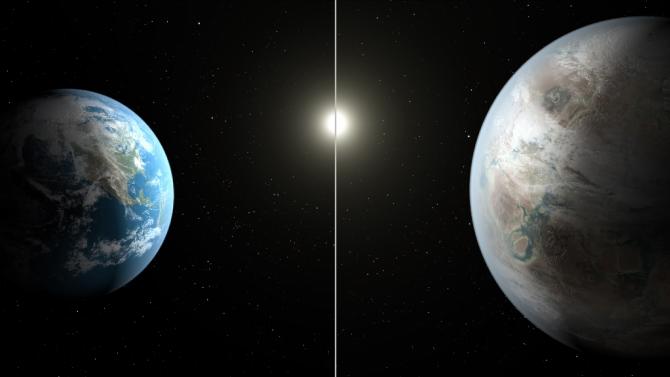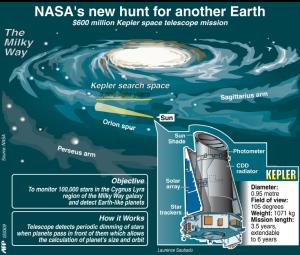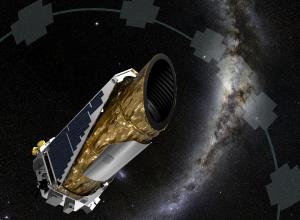
Inching ahead on their quest for what they call Earth 2.0, astronomers from NASA’s Kepler
planet-hunting spacecraft announced on Thursday that they had found
what might be one of the closest analogues to our own world yet.
It is a planet a little more than one and a half times as big in radius as Earth. Known as Kepler
452b, it circles a sunlike star in an orbit that takes 385 days, just
slightly longer than our own year, putting it firmly in the “Goldilocks”
habitable zone where the temperatures are lukewarm and suitable for
liquid water on the surface — if it has a surface.
The
new planet’s size puts it right on the edge between being rocky like
Earth and being a fluffy gas ball like Neptune, according to studies of
other such exoplanets. In an email, Jon Jenkins of NASA’s
Ames Research Center, home of the Kepler project, and lead author of a
paper being published in The Astronomical Journal, said the likelihood
of the planet’s being rocky was 50 percent to 62 percent, depending on
uncertainties in the size of its home star. That would mean its mass is
about five times that of Earth.
Interactive Feature
Kepler’s Tally of Planets
NASA’s Kepler mission has discovered more than 1,000 confirmed planets orbiting distant stars.

Such
a planet would probably have a thick, cloudy atmosphere and active
volcanoes, Dr. Jenkins said, and twice the gravity of Earth. Describing
the planet during a news conference, Dr. Jenkins lapsed into lines from
John Keats’s poem “On First Looking Into Chapman’s Homer”: “Then felt I
like some watcher of the skies / When a new planet swims into his ken.”
The
star that lights this planet’s sky is about 1.5 billion years older
than our sun and 20 percent more luminous, which has implications for
the prospects of life, Dr. Jenkins said.
“We can think of Kepler-452b as an older, bigger cousin
to Earth, providing an opportunity to understand and reflect upon
Earth’s evolving environment,” he said. “It’s awe-inspiring to consider
that this planet has spent six billion years in the habitable zone of
its star, longer than Earth. That’s substantial opportunity for life to
arise, should all the necessary ingredients and conditions for life
exist on this planet.”
Asked
if any radio telescopes had pointed at the planet to try to detect
extraterrestrial radio broadcasts, Dr. Jenkins said, “I hope so.”
To
determine whether Kepler 452b deserves a place on the honor roll of
possible home worlds, however, astronomers have to measure its mass
directly, which requires being close enough to observe the wobbling of
its star as it is tugged around by the planet’s gravity. For now, that
is impossible, as Kepler 452b is 1,400 light-years away.

The
planet is the first to be confirmed in a new list of candidates
unveiled by Kepler astronomers on Thursday. It brings the number of
possible planets discovered by Kepler to 4,696, many of them small like
Earth. “We are the bread crumbs of the universe,” said Jeff Coughlin, of
the SETI Institute in Mountain View, Calif., who compiled the catalog.
The
spacecraft, launched in 2009, spent four years staring at a patch of
the Milky Way on the border between the constellations Cygnus and Lyra,
looking for the dips in starlight caused by the passage of planets. Its pointing system failed in 2013, but astronomers are still analyzing the data Kepler collected. Every time they sift through it, new planets pop out.
In the meantime, Kepler has switched to a different mode of observing in a mission called K2.
The
NASA news conference coincided with a major anniversary: It was only 20
years ago this fall that Michel Mayor and Didier Queloz, of the
University of Geneva, discovered a planet circling the star 51 Pegasi,
about 50 light-years from here. It was the first planet known to belong
to a sunlike star outside our solar system, and its discovery ignited an
astronomical revolution.
Dr. Queloz, now at the University of Cambridge in England, said at the news conference, “This is a great time we live in.”
“If
we keep working so well and so enthusiastically,” he went on, it is not
too optimistic to think that in the future, “the issue of life on
another planet will be solved.”
Astronomers
say they now know from Kepler that about 10 percent of the 200 billion
stars in the Milky Way have potentially habitable Earth-size planets,
Kepler 452b probably among them. This means that of the 600 stars within
30 light-years of Earth, there are roughly 60 E.T.-class abodes,
planets that could be inspected by a future generation of telescopes.
Miami (AFP) - Astronomers hunting for another Earth have
found the closest match yet, a potentially rocky planet circling its
star at the same distance as our home orbits the Sun, NASA said
Thursday.
Named Kepler 452b, the planet is about 60 percent
larger than Earth. It could have active volcanoes, oceans, sunshine like
ours, twice as much gravity and a year that lasts 385 days, scientists
said.
"Today we are announcing the discovery of an exoplanet that, as far we can tell, is a pretty good close cousin to the Earth and our Sun," said John Grunsfeld, associate administrator for NASA's Science Mission Directorate in Washington.
NASA has made a handful of such announcements in the past, but each of those discoveries fell short of being Earth-like in one way or another, such as being too hot to host life or having a surface that was likely gaseous rather than hard and rocky.
"This is about the closest so far," Grunsfeld added, describing Kepler 452b as our "closest twin," or "Earth 2.0."
The planet was detected by the US space agency's Kepler Space Telescope, which has been hunting for other worlds like ours since 2009.
This planet sits squarely in the Goldilocks zone of its star, where life could exist because it is neither too hot nor too cold to support liquid water, the US space agency said.
- 'New kid on the block' -
"Today the Earth is a little less lonely," said Jon Jenkins, Kepler data analysis lead scientist at NASA's Ames Research Center in Moffett Field, California.
"Because there is a new kid on the block that just moved in next door, in terms of the surface temperature of the star it orbits and the energy it receives from its star."
Kepler 452b's star is 1.5 billion years older, four percent more massive and 10 percent brighter than our Sun.
But at a distance of 1,400 light-years away, humankind has little hope of reaching this Earth-twin any time soon.
"This is really the first step -- and I think humankind's first step -- at answering that question of, 'Are we alone in the universe?'" said Jeff Coughlin, Kepler research scientist at the Search for Extraterrestrial Intelligence (SETI) Institute in Mountain View, California.
"You and I probably won't be traveling to any of these planets without some unexpected breakthrough, but you know, our children's children's children may."
If the planet is rocky -- and scientists believe that it has a better-than-even chance of being just that -- then it could be headed for a fearful scenario, as the heat from its dying star evaporates Kepler 452b's lakes and oceans.
"Its location vis-a-vis its star could mean that it is just entering a runaway greenhouse phase of its climate history," said Doug Caldwell, a SETI Institute scientist working on the Kepler mission.
"The increasing energy from its aging sun might be heating the surface and evaporating any oceans. The water vapor would be lost from the planet forever," he added.
"Kepler 452b could be experiencing now what the Earth will undergo more than a billion years from now, as the Sun ages and grows brighter."
Jenkins was more optimistic, however, based on the planet's age, size, and higher mass and gravity than on Earth.
"This planet is protected at least for a little while longer, 500 million years or so, from experiencing the runaway greenhouse (effect), assuming that it is six billion years old," he told reporters.
- Planetary catalog -
The Kepler mission launched in 2009 to search for exoplanets, which are planets outside our solar system, particularly those about the size of Earth or smaller.
On Thursday, NASA released the latest catalog of exoplanet candidates, adding more than 500 new possible planets for a total of 4,696 found by the space-based telescope.
"The confirmation of Kepler-452b brings the total number of confirmed planets to 1,030," NASA said.
The new catalog includes 12 candidates that are less than twice the diameter of Earth and which are orbiting in the habitable zones of their stars.
NASA discovers closest Earth-twin yet
"Today we are announcing the discovery of an exoplanet that, as far we can tell, is a pretty good close cousin to the Earth and our Sun," said John Grunsfeld, associate administrator for NASA's Science Mission Directorate in Washington.
NASA has made a handful of such announcements in the past, but each of those discoveries fell short of being Earth-like in one way or another, such as being too hot to host life or having a surface that was likely gaseous rather than hard and rocky.
"This is about the closest so far," Grunsfeld added, describing Kepler 452b as our "closest twin," or "Earth 2.0."
The planet was detected by the US space agency's Kepler Space Telescope, which has been hunting for other worlds like ours since 2009.
This planet sits squarely in the Goldilocks zone of its star, where life could exist because it is neither too hot nor too cold to support liquid water, the US space agency said.
- 'New kid on the block' -
"Today the Earth is a little less lonely," said Jon Jenkins, Kepler data analysis lead scientist at NASA's Ames Research Center in Moffett Field, California.
"Because there is a new kid on the block that just moved in next door, in terms of the surface temperature of the star it orbits and the energy it receives from its star."
Kepler 452b's star is 1.5 billion years older, four percent more massive and 10 percent brighter than our Sun.
But at a distance of 1,400 light-years away, humankind has little hope of reaching this Earth-twin any time soon.
"This is really the first step -- and I think humankind's first step -- at answering that question of, 'Are we alone in the universe?'" said Jeff Coughlin, Kepler research scientist at the Search for Extraterrestrial Intelligence (SETI) Institute in Mountain View, California.
"You and I probably won't be traveling to any of these planets without some unexpected breakthrough, but you know, our children's children's children may."
If the planet is rocky -- and scientists believe that it has a better-than-even chance of being just that -- then it could be headed for a fearful scenario, as the heat from its dying star evaporates Kepler 452b's lakes and oceans.
"Its location vis-a-vis its star could mean that it is just entering a runaway greenhouse phase of its climate history," said Doug Caldwell, a SETI Institute scientist working on the Kepler mission.
"The increasing energy from its aging sun might be heating the surface and evaporating any oceans. The water vapor would be lost from the planet forever," he added.
"Kepler 452b could be experiencing now what the Earth will undergo more than a billion years from now, as the Sun ages and grows brighter."
Jenkins was more optimistic, however, based on the planet's age, size, and higher mass and gravity than on Earth.
"This planet is protected at least for a little while longer, 500 million years or so, from experiencing the runaway greenhouse (effect), assuming that it is six billion years old," he told reporters.
- Planetary catalog -
The Kepler mission launched in 2009 to search for exoplanets, which are planets outside our solar system, particularly those about the size of Earth or smaller.
On Thursday, NASA released the latest catalog of exoplanet candidates, adding more than 500 new possible planets for a total of 4,696 found by the space-based telescope.
"The confirmation of Kepler-452b brings the total number of confirmed planets to 1,030," NASA said.
The new catalog includes 12 candidates that are less than twice the diameter of Earth and which are orbiting in the habitable zones of their stars.
Kepler identifies
possible planets by watching for dips in the brightness of stars, which
could be caused by a planet passing between the star and the telescope.
Other scientific tools are needed to judge whether the planet is gassy or rocky and what its mass may be.
The Kepler mission has cost NASA about $600 million.
Two
years ago, NASA announced that two of Kepler's four orientation wheels
had broken down, leaving the space telescope beyond repair.
Another
NASA spacecraft, called TESS (The Transit Exoplanet Survey Satellite)
is scheduled to launch in 2017 on a mission to find the closest
habitable planets to Earth.




No comments:
Post a Comment